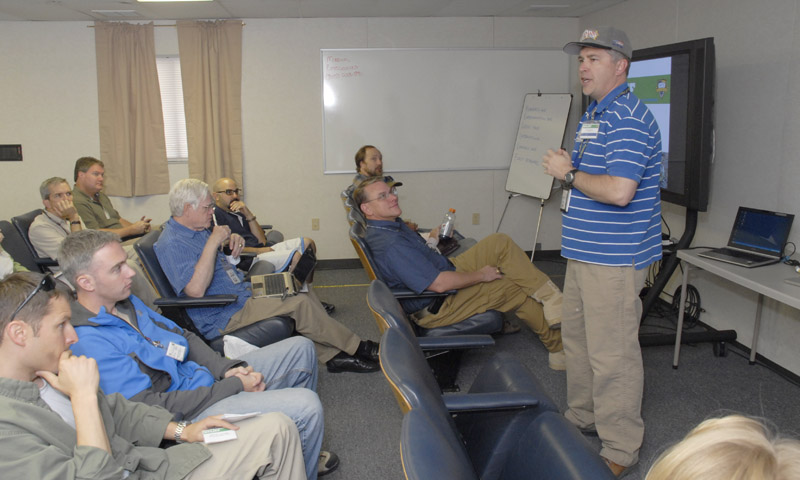NPS researchers are frequently involved in emergency response and homeland security research projects, looking to assist in disaster response and prevention efforts worldwide. One such program looks to give students a testbed for their theses as well as a chance to connect with emergency response personnel, the Research and Experimentation for Local and International Emergency and First Responders (RELIEF) program.
Over 90 participants from 46 organizations and branches of government recently spent three days at the United States Special Operations Command (SOCOM) NPS Tactical Network Testbed (TNT) at Camp Roberts, Calif., to explore humanitarian assistance and disaster response (HA/DR) experiments including Crowdsourcing to Complete HA/DR Requests and Situational Awareness with Inoperable Networks.
“Projects are selected for RELIEF based on the context of the issues they aim to address,” explained NPS Research Assistant Tristan Allen. “RELIEF does not seek to identify any single set of solutions, rather, we accept most applicants who seek to address a broad set of issues that deal with humanitarian assistance and disaster response.”
“The idea is that we bring government, academic, non-government organizations and commercial entities together in an environment that encourages exploration and tolerates failure to try new ideas that will enhance our ability to respond to crises around the world,” added TNT RELIEF Director, NPS Information Sciences Associate Professor Dr. Ray Buettner.
One of the experiments represented at Camp Roberts for RELIEF 11-4 was a thesis project by NPS students Lt. j.g. Deward Cummings and Lt. Paul Mahoney titled the Explosive Remnants of War Collection Points (ERW-CPs). Their project explored the potential to design small structures of readily available materials, which serve as a collection box for explosive remnants of war.
"ERW is an issue in any country or region in which an armed conflict has occurred on its soil,” wrote Cummings in his thesis proposal. “In Afghanistan alone, over 2,000 communities or 1,303,553 people remain affected by landmines, ERW, and abandoned Improvised Explosive Devices (IEDs) with an average of 40 Afghans killed or injured every month by unexploded ordnance.”
The students looked at utilizing paper products and indigenous materials in their design. They have future plans to detonate a fragment-producing charge inside the container to test how securely the structure is able to contain the explosion.
“The design methods are intended to be very simple. The entire kit for this cost $500, yet you can also build walls, buildings, structures using this fibrous concrete,” said Buettner. “So it will teach the locals how to use their indigenous materials to build better structures to enhance their own life and their own security.”

TNT RELIEF Director, NPS Information Sciences Associate Professor Dr. Ray Buettner, welcomes attendees from around the country to RELIEF 11-4, August 3-5 at Camp Roberts.
Buettner noted that funds for humanitarian assistance and disaster relief are generally limited, forcing the community to develop ways of making due with scarce resources. Part of what makes these collaborative efforts successful is the coalescence of a community of HA/DR experts – large projects are effectively moved along with the input of many groups or people despite lack of funds.
“With SOCOM’s support, we’re trying to build a large community that can rapidly explore, adapt and deploy technologies that can support humanitarian assistance and disaster relief operations,” explained Buettner. “That work has had amazing success. TNT and RELIEF are very different in that the former defense-oriented community tends to have lots of resources. The RELIEF community is very resource challenged, so they have to be more innovative about how they deal with things.”
Innovation and collaboration could be seen across RELIEF 11-4 as individual groups and organizations discussed components of their research that could use the expertise of other groups. While one project might be looking to build a structure for a specific purpose, another team might be able to provide their expertise on how to power the tools needed to build such structures in third world countries. Research Assistant Rosa Akbari explained that the innovation and collaboration that is fostered by RELIEF is one of the driving forces behind the program’s success.
“The purpose of experimentation is to link technological developers with end users in hopes of producing the most relevant products for humanitarian practitioners by the time they reach the field,” explained Akbari. “Experiments in the past have aimed to improve capabilities in areas like geospatial imagery sharing, crowdsourced communications, network connectivity, and sustainable power generation.”
RELIEF projects and participants are involved in emergency response scenarios around the world, including immediately following the earthquake in Haiti. This past RELIEF, the National Geospatial-Intelligence Agency (NGA) explored geospatial information sharing with non-governmental organizations, inspired by a shortage of maps available in Haiti’s disaster relief operations. In response to the disaster, volunteers created a patchwork of maps of road systems and critical infrastructures. One goal of NGA participants was to discuss policy that would harness the collective cooperation and investment of volunteer geographers to quickly produce global maps, leveraging volunteers’ quick response in Haiti in other disaster response operations. Participants were also able to connect with other organizations, including the Situational Awareness Geospatial Enterprise, to help further their project.
"All efforts aim to improve first responders’ and humanitarian workers’ abilities to assist affected populations,” said Akbari. “Whether bolstering communication capabilities or facilitating social connections with fellow practitioners, RELIEF allows individuals to build cross organizational trust before disaster strikes. These relationships are what facilitate better responses in the field – people know who to call, when to call them, and what to call them for.”

